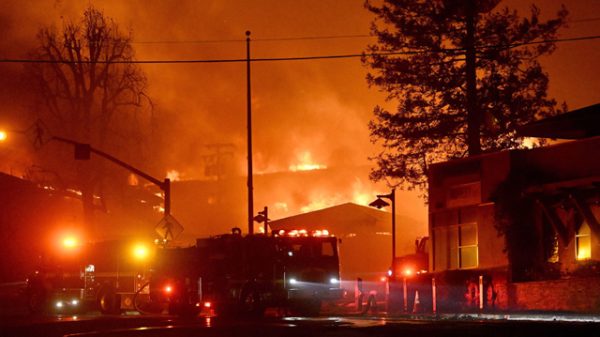

At least five people have been killed in rampaging wildfires around Los Angeles, officials said Wednesday, with firefighters overwhelmed by the speed and ferocity of multiple blazes.
Up to 1,500 buildings have burned in fires that have broken out around America’s second biggest city, forcing over 100,000 people from their homes.
Hurricane-force winds whipped up fireballs that leapt from house to house in the upmarket Pacific Palisades area, incinerating a swathe of California’s most desirable real estate favored by Hollywood celebrities.
Los Angeles County Fire Chief Anthony Marrone said his crews were overwhelmed by the scale and speed of the unfolding disasters.
“We’re doing the very best we can. But no, we don’t have enough fire personnel in LA County between all the departments to handle this,” he said.
The fire raging in Pacific Palisades had consumed around 16,000 acres (6,500 hectares) as of Wednesday afternoon, taking 1,000 homes and businesses with it.
A separate 10,600-acre fire was burning around Altadena, north of the city, where flames tore through suburban streets.
Los Angeles County Sheriff Robert Luna said five people were known to have perished, with
more deaths feared.
“Remember, this is still a very fluid situation, there’s zero containment on this fire. I’m really praying we don’t find more, but I don’t think that’s going to be the case,” he said.
William Gonzales got out alive, but his Altadena home was gone.
“We have lost practically everything; the flames have consumed all our dreams,” he told AFP.
“We evacuated at 3 am when the authorities asked us to leave and we had to leave. I can see my house, but it is no longer a house.”
– Hydrants run dry –
Pasadena fire chief Chad Augustin said up to 500 buildings had been lost to the flames.
He hailed the bravery of first responders who had saved lives.
“Our death count today would be significantly higher without their heroic actions.”
Vicious gusts pushed the flames, whipping red-hot embers hundreds of yards (meters) and sparking new spot fires faster than firefighters could quell them.
As a pall of dark smoke hung over Los Angeles, downed trees and broken branches were hampering movement, and residents were urged to stay off the roads.
Los Angeles Department of Water and Power chief executive Janisse Quinones pleaded with people to save water after hydrants in Pacific Palisades ran dry.
President-elect Donald Trump took to his social media platform on Wednesday to claim — wrongly — that the lack of water was the result of the state’s environmental policies.
In fact, much of Los Angeles’ water comes from the Colorado River, and farming — rather than residential use or firefighting — takes the lion’s share of all water that flows into Southern California.
Joe Biden, who was in Los Angeles with California Governor Gavin Newsom, was briefed on what the president called an “astounding” situation.
“We’re doing anything and everything, and as long as it takes to contain these fires,” Biden told reporters.
– ‘Panic mode’ –
Having razed perhaps hundreds of multimillion-dollar homes, the Pacific Palisades fire looked set to be one of the costliest blazes on record.
AccuWeather said it estimated up to $57 billion of losses had been caused in the multiple disasters.
Martin Sansing, 54, told AFP he has lived in Santa Monica canyon for 20 years and had never seen anything similar.
“We’re in a pretty urban area. We’re not like, on a hill or anything like that. I never imagined we would be affected,” he said.
More than 1.5 million households were without electricity in the region, according to the website outage.us. Utilities in California frequently de-energize lines during high winds to minimize the risk of new fires.
Wildfires are part of life in the US West and play a vital role in nature.
But scientists say human-caused climate change is altering weather patterns.
Southern California had two decades of drought that were followed by two exceptionally wet years, which sparked furious vegetative growth — leaving the region packed with fuel and primed to burn.
Meteorologist Daniel Swain said the fierce winds — which have gusted up to 100 miles (160 kilometers) an hour — are stronger than the usual seasonal Santa Ana winds, but are not unexpected.
“The winds are the driver, but the real catalyst… is this incredible antecedent dryness,” he said.
“The lack of rain and the anomalous warmth and dryness that we’ve seen the past six months. That’s something that we haven’t seen in records going back to the 1800s.”
Leave a Reply